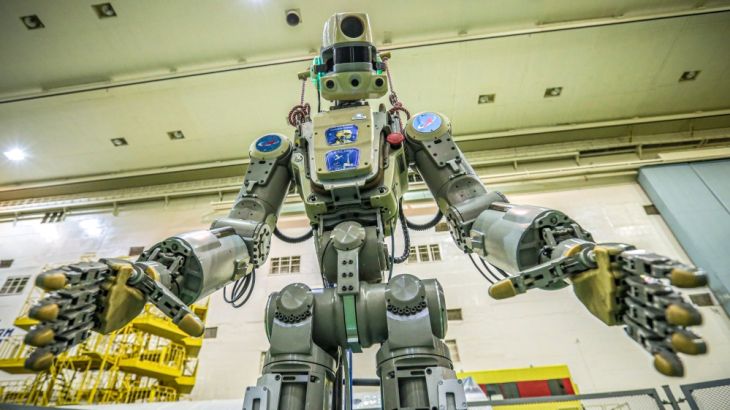‘Let’s go’: Russia launches humanoid robot Fedor into space
Space-bound humanoid robot Fedor expected to dock at the ISS on Saturday with more than 650kg of cargo.

A Russian humanoid robot is on its way to the International Space Station (ISS) after blasting off on a 10-day mission to support the astronauts on board.
Known as Fedor, which stands for Final Experimental Demonstration Object Research, the Skybot F-850 became the first humanoid robot to be sent to space by Russia after it was launched from the Baikonur Cosmodrome in Kazakhstan on Thursday.
Keep reading
list of 4 itemsRussia’s Angara A5 rocket blasts off into space after two aborted launches
Photos: Mexico, US, Canada mesmerised by rare total solar eclipse
Moment total solar eclipse occurs in North America
Travelling in an unmanned Soyuz MS-14 spacecraft, Fedor is expected to dock at the ISS on Saturday with more than 650kg of cargo, including medical supplies and food rations for the crew waiting at the station.
The spacecraft is scheduled to stay until September 7.
We have liftoff of the unpiloted Soyuz MS-14 test flight to pave the way for future crew launches to the International Space Station. #AskNASA | https://t.co/cBNqC61h27 pic.twitter.com/BXKdzNBt4O
— Intl. Space Station (@Space_Station) August 22, 2019
“The robot’s main purpose is to be used in operations that are especially dangerous for humans on board spacecraft and in outer space,” Russian space agency Roscosmos said after the launch.
The ISS is a joint project of the space agencies of the United States, Russia, Europe, Japan and Canada.
Flying the flag for Russia
Fedor, which is the size of an adult and can emulate movements of the human body, was strapped into a specially adapted pilot’s seat for the journey, with a small Russian flag in hand.
“Let’s go. Let’s go,” the robot was heard saying during the launch, repeating the famous phrase used by the first man in space, Yuri Gagarin.
Fedor has Instagram and Twitter accounts, with posts saying it is learning new skills such as opening a bottle of water. In the station, it will try those manual skills in very low gravity.
“That’s connecting and disconnecting electric cables [and] using standard items, from a screwdriver and a spanner to a fire extinguisher,” the Russian space agency’s director for prospective programmes and science, Alexander Bloshenko, said in televised comments before the launch.
Bloshenko added that it is hoped robots such as Fedor will eventually carry out dangerous operations such as spacewalks.
‘Everything is normal’
The robot is described as “an assistant to the ISS crew” on his Twitter page which has 4,600 followers.
Assuring his fans he was on his way to the ISS without any hitches following the lift-off, Fedor tweeted “everything is normal” a few hours into his flight.
Though a first for Russia, Fedor’s journey does not mark an inaugural passage for a robot into space.
In 2011, NASA sent up Robonaut 2, a humanoid robot developed with General Motors that had a similar aim of working in high-risk environments.
It was flown back to the Earth in 2018 after experiencing technical problems.
In 2013, Japan sent up a small robot called Kirobo along with the ISS’s first Japanese space commander. Developed with Toyota, it was able to hold conversations – albeit exclusively in Japanese.